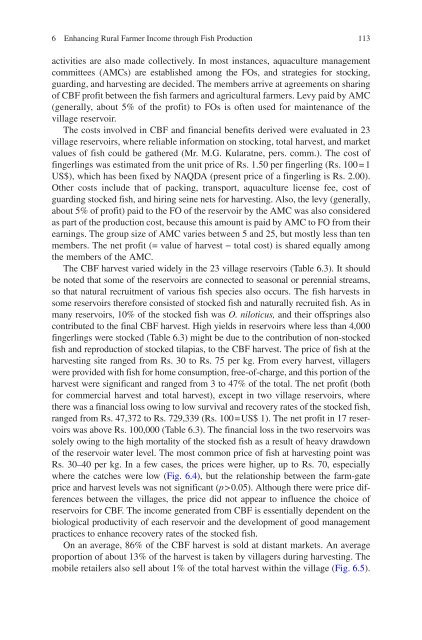Success Stories In Asian Aquaculture - Library - Network of ...
Success Stories In Asian Aquaculture - Library - Network of ...
Success Stories In Asian Aquaculture - Library - Network of ...
- No tags were found...
Create successful ePaper yourself
Turn your PDF publications into a flip-book with our unique Google optimized e-Paper software.
6 Enhancing Rural Farmer <strong>In</strong>come through Fish Production113activities are also made collectively. <strong>In</strong> most instances, aquaculture managementcommittees (AMCs) are established among the FOs, and strategies for stocking,guarding, and harvesting are decided. The members arrive at agreements on sharing<strong>of</strong> CBF pr<strong>of</strong>it between the fish farmers and agricultural farmers. Levy paid by AMC(generally, about 5% <strong>of</strong> the pr<strong>of</strong>it) to FOs is <strong>of</strong>ten used for maintenance <strong>of</strong> thevillage reservoir.The costs involved in CBF and financial benefits derived were evaluated in 23village reservoirs, where reliable information on stocking, total harvest, and marketvalues <strong>of</strong> fish could be gathered (Mr. M.G. Kularatne, pers. comm.). The cost <strong>of</strong>fingerlings was estimated from the unit price <strong>of</strong> Rs. 1.50 per fingerling (Rs. 100 = 1US$), which has been fixed by NAQDA (present price <strong>of</strong> a fingerling is Rs. 2.00).Other costs include that <strong>of</strong> packing, transport, aquaculture license fee, cost <strong>of</strong>guarding stocked fish, and hiring seine nets for harvesting. Also, the levy (generally,about 5% <strong>of</strong> pr<strong>of</strong>it) paid to the FO <strong>of</strong> the reservoir by the AMC was also consideredas part <strong>of</strong> the production cost, because this amount is paid by AMC to FO from theirearnings. The group size <strong>of</strong> AMC varies between 5 and 25, but mostly less than tenmembers. The net pr<strong>of</strong>it (= value <strong>of</strong> harvest − total cost) is shared equally amongthe members <strong>of</strong> the AMC.The CBF harvest varied widely in the 23 village reservoirs (Table 6.3 ). It shouldbe noted that some <strong>of</strong> the reservoirs are connected to seasonal or perennial streams,so that natural recruitment <strong>of</strong> various fish species also occurs. The fish harvests insome reservoirs therefore consisted <strong>of</strong> stocked fish and naturally recruited fish. As inmany reservoirs, 10% <strong>of</strong> the stocked fish was O. niloticus, and their <strong>of</strong>fsprings alsocontributed to the final CBF harvest. High yields in reservoirs where less than 4,000fingerlings were stocked (Table 6.3 ) might be due to the contribution <strong>of</strong> non-stockedfish and reproduction <strong>of</strong> stocked tilapias, to the CBF harvest. The price <strong>of</strong> fish at theharvesting site ranged from Rs. 30 to Rs. 75 per kg. From every harvest, villagerswere provided with fish for home consumption, free-<strong>of</strong>-charge, and this portion <strong>of</strong> theharvest were significant and ranged from 3 to 47% <strong>of</strong> the total. The net pr<strong>of</strong>it (bothfor commercial harvest and total harvest), except in two village reservoirs, wherethere was a financial loss owing to low survival and recovery rates <strong>of</strong> the stocked fish,ranged from Rs. 47,372 to Rs. 729,339 (Rs. 100 = US$ 1). The net pr<strong>of</strong>it in 17 reservoirswas above Rs. 100,000 (Table 6.3 ). The financial loss in the two reservoirs wassolely owing to the high mortality <strong>of</strong> the stocked fish as a result <strong>of</strong> heavy drawdown<strong>of</strong> the reservoir water level. The most common price <strong>of</strong> fish at harvesting point wasRs. 30–40 per kg. <strong>In</strong> a few cases, the prices were higher, up to Rs. 70, especiallywhere the catches were low (Fig. 6.4 ), but the relationship between the farm-gateprice and harvest levels was not significant ( p > 0.05). Although there were price differencesbetween the villages, the price did not appear to influence the choice <strong>of</strong>reservoirs for CBF. The income generated from CBF is essentially dependent on thebiological productivity <strong>of</strong> each reservoir and the development <strong>of</strong> good managementpractices to enhance recovery rates <strong>of</strong> the stocked fish.On an average, 86% <strong>of</strong> the CBF harvest is sold at distant markets. An averageproportion <strong>of</strong> about 13% <strong>of</strong> the harvest is taken by villagers during harvesting. Themobile retailers also sell about 1% <strong>of</strong> the total harvest within the village (Fig. 6.5 ).
















